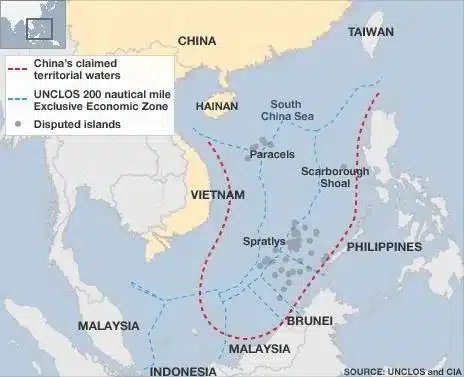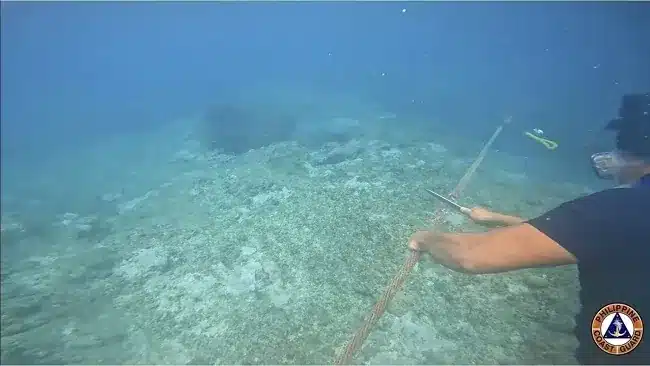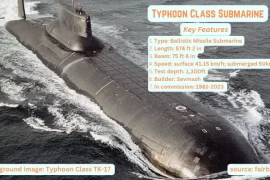The Scarborough Shoal has again become a global geopolitical flashpoint. This time Philippine Coast Guard cut a sea barrier erected by Chinese forces to restrict Philippine fishing in waters surrounding the Scarborough Shoal which both countries claim as a port of their maritime domain. This assertive move by the Philippines signifies a notable shift towards a more robust foreign policy stance against China, and it holds broader implications for the entire Indo-Pacific region, given the Philippines’ crucial role as a key ally of the United States.
Background to the recent crisis
China’s ‘nine-dash line’ map extends its sovereignty claims far beyond its coastline, encompassing territories also claimed by neighboring countries, including the Philippines.
The Philippines, on the other hand, asserts its rights under international law, notably the United Nations Convention on the Law of the Sea (UNCLOS). According to UNCLOS, the Philippines has exclusive rights to its exclusive economic zone (EEZ), which includes areas near Scarborough Shoal.

In 2016, the Permanent Court of Arbitration in The Hague issued a landmark ruling, declaring that China’s claims in the South China Sea had no legal basis under international law. Despite the ruling, China has refused to acknowledge it and continues to assert its territorial claims.
Regarding Scarborough Shoal, China has exerted control over it since 2012, deploying Coast Guard vessels and fishing fleets to strengthen its presence. Many security experts view these actions as proxies of the Chinese Navy.
In response, the Philippines has staunchly defended its fishermen’s rights to access these waters. Recent actions by the Philippine Coast Guard, such as removing floating barriers placed by China, demonstrate Manila’s growing defiance of Beijing’s territorial claims.
Philippines’ strategy to counter China
The Philippines is pursuing a multifaceted strategy to counter China’s assertiveness in the South China Sea. While being cautious about economic dependencies on China, the Philippines aims to balance security and economic interests to protect its territorial integrity.
On September 10, 2023, Philippine Defense Secretary Gilbert Teodoro emphasized the need for comprehensive planning, with a focus on forming alliances and modernizing their naval capabilities. The Philippines’ strategy to counter China addresses concerns about being outmatched by China and involves forging strategic partnerships with like-minded nations.
The decision to cut the barriers was a direct result of President Ferdinand E. Marcos Jr.’s orders. Since assuming office in June 2022, Mr. Marcos has clearly indicated his desire for a more assertive foreign policy stance towards China. He has strengthened the security ties with the United States.
There’s no denying that the Philippines felt emboldened to cut the barrier, given the continuous support and encouragement it receives from the United States to confront China in the South China Sea.
The Philippines has a long and intricate history of military cooperation and disputes with the United States. Dating back to the Spanish-American War in 1898, which led to the transfer of the Philippines from Spanish rule to American control, the country has held strategic importance for American military installations in the Pacific region. Presently, there are nine US military bases in the Philippines, including Subic Bay Naval Base, Antonio Bautista Air Base, and Clark Air Base. In April 2023, the United States secured access to an additional four bases within the Philippines.
However, Ferdinand Marcos Jr.’s predecessor Rodrigo Duterte implemented a foreign policy pivot away from the United States, the country’s long-standing treaty ally. Duterte aimed to diversify international relationships by strengthening ties with China and Russia to achieve economic benefits and reduce reliance on the United States. This shift strained relations with the U.S. and challenged traditional alliances.

In contrast, Ferdinand Marcos Jr. is steering the Philippines back toward closer relations with the United States, emphasizing alliances and modernizing its naval capabilities to address regional security concerns, particularly in the South China Sea.
This shift in policy has drawn Beijing’s ire, as it perceives an emerging chain of alliances spanning from South Korea and Japan in the north to Australia in the south, all within close proximity to China.
Reacting to the revelation of the positions of four newly established US military bases in the Philippines, for example, Chinese Foreign Ministry Spokesperson Mao Ning stated, “It is evident that the US has been escalating its military presence in the area, guided by a zero-sum mindset in pursuit of its own interests. This can only result in heightened tensions and diminished peace and stability within the region.”
A broader regional challenge
China’s territorial claims have strained relations not only with the Philippines but also with other maritime neighbors like Vietnam, Taiwan, and Malaysia.
The Philippines’ stance also mirrors what Malaysia and Indonesia did recently when both countries sent their ships to survey in disputed waters despite threats from China.
In a notable display of regional collaboration and solidarity, all ten member states of the Association of Southeast Asian Nations (ASEAN) have united to initiate a joint military exercise known as ‘ASEX 01-Natuna Exercises’ on September 19, 2023.
The timing of these exercises is especially significant, given the escalating tensions in the South China Sea. These military drills come in the wake of an ASEAN defense leaders’ meeting held in Bali in June 2023 and the conclusion of the annual Super Garuda Shield military exercise co-hosted by Indonesia and the United States. Notably, this year’s edition witnessed expanded participation, including Japan, Australia, Singapore, and the U.K.
However, it is important to highlight that the Natuna exercise was initially planned to take place along the periphery of the South China Sea but was relocated to Indonesia’s South Natuna Sea to avoid potential disputes and friction with China.
This further underscores the intricate geopolitical dynamics of the South China Sea region, as nations at odds with China have taken a relatively bolder stance while still wrestling with the challenge of engaging constructively with China. The overarching consensus thus far has been to prioritize stability and to favor dialogue and diplomacy whenever feasible.







